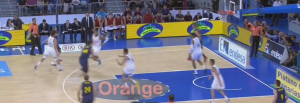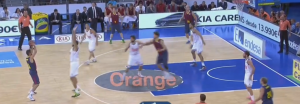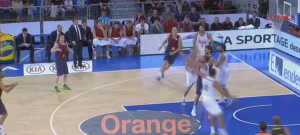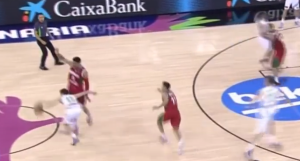In Non-Moving Pictures: Real Madrid tinker with their defense
Perhaps the most remarkable thing about Real Madrid trashing Barcelona at the Supercopa final was how ordinary it felt. This was an exhilarating performance – to the tune of 99 points, 57% shooting from beyond the arc and a 21-point win against the reigning Spanish champions – that somehow felt familiar, almost to be expected. Even on the defensive end, Madrid’s ability to generate twenty points off their opponents’ turnovers was noteworthy but not that surprising for a team that posted the second-highest steals percentage last Euroleague season.
Then again, Sunday’s triumph represented a major upgrade in the defensive efficiency of the Supercopa winners compared to the second half of last season, when on most possessions it seemed that they would either get a steal or get scored on. Containing Barcelona’s pick and roll game was key. Madrid did not appear to introduce any new defensive principles, but they were definitely more determined to meet the ball handler as far away from the basket as possible, in order to eliminate the mid-range threat posed by Huertas shots off one leg, Navarro bombitas and Tomic short rolls:
Last season, Pablo Laso seemed mostly reluctant to have his big men step outside the three – point line. This was not the case in the two Supercopa games. However, off the ball action was just as important, as the weak side defender closest to the top of the key was charged with bumping the roll man in order to give Madrid’s center enough time to recover. The best case scenario for this strategy can be summed up in the following screencap:
Rudy rotates toward Tomic just in time to pick up the steal, eliminating the sort of action that gave Madrid a bunch of problems last season. This is not to say that things worked out like this all of the time:
Such rotations tend to give up a fairly open three pointer from the weak side. Therefore, the help defender doing the bumping (KC Rivers on the above picture) is often forced to get back to his man before the Madrid center has recovered. On this play, Huertas made the bridge pass to Tomic, who converted inside. One solution for Madrid would be to have Reyes, suddenly turned into weak side defender, rotate deeper into the paint. Lampe’s three point percentage, coupled with the degree of difficulty on a potential crosscourt pass would justify that adjustment. In any case, Madrid have a couple of other options at their disposal, the first being a pretty straightforward switch:
It remains to be seen whether Madrid bigs can keep Europe’s most dangerous slashers in front of them long enough to make this strategy work. However, things got more interesting once the entry pass to the roll man connected:
It’s hard to tell at this early stage of the season whether Madrid blitzed Tomic with four defenders because of a conscious tactical decision or due to defensive rotations that are – quite understandably – a work in progress. Obviously, the resulting open three taken by Navarro is too steep a price to pay for taking away a high percentage shot inside. However, Laso’s experimentation with a switch defense was the most notable change in Madrid’s defensive set up. And in the long run it could help his teams minimize defensive rotations and open threes, without risking too many attempts in the paint.
The second option could be provided by Gustavo Ayon. The Mexican center/forward does not stand out as a rim protector. In a three-game sample from the World Cup (against the Euroleague or NBA caliber talent of Lithuania, Australian and Slovenia), opponents made fourteen of the twenty one shots in the paint that were contested by Ayon. That’s a 66% mark, which is not completely awful, but still higher than the average percentage for shots at the rim taken by Euroleague teams last season (small sample disclaimer applies). Ayon is also quite foul prone, but he can hedge out, even against Goran Dragic:
Madrid haven’t been doing a whole lot of that under Laso, but it seems that they are looking for ways to rotate under their own terms. Preventing the ball handler on the pick and roll from turning the corner is one way to buy time for help defenders. Ayon also saw a few minutes at power forward, which is not a bad idea, given Madrid’s efficiency without a stretch four in their lineup and Nocioni’s habbit of getting beat by his man off the dribble. But his footwork against the pick and roll could be a valuable asset, even in limited minutes. With Marcus Slaughter seemingly the odd man out of Madrid’s deep front line, Laso needs a big man who can stop the ball. It remains to be seen whether Ayon can fill that role.





